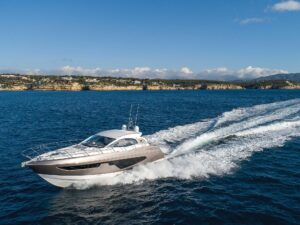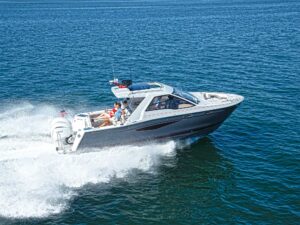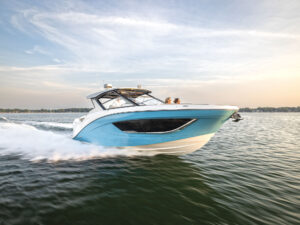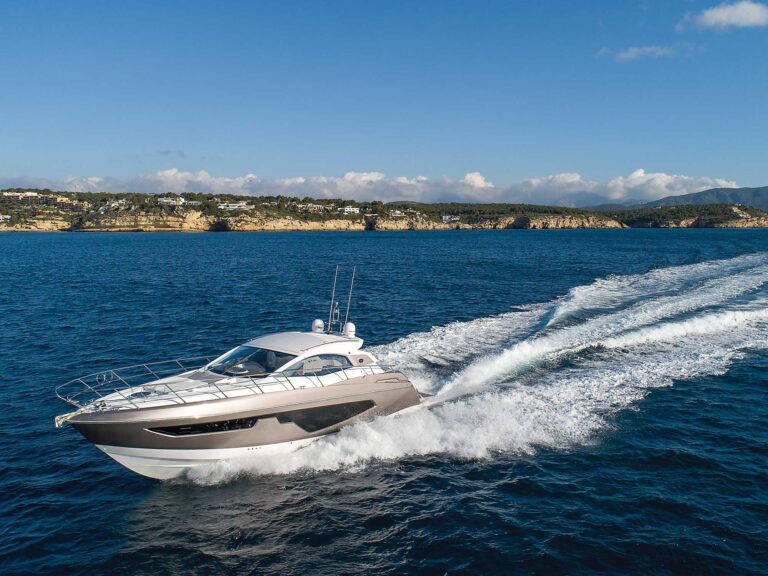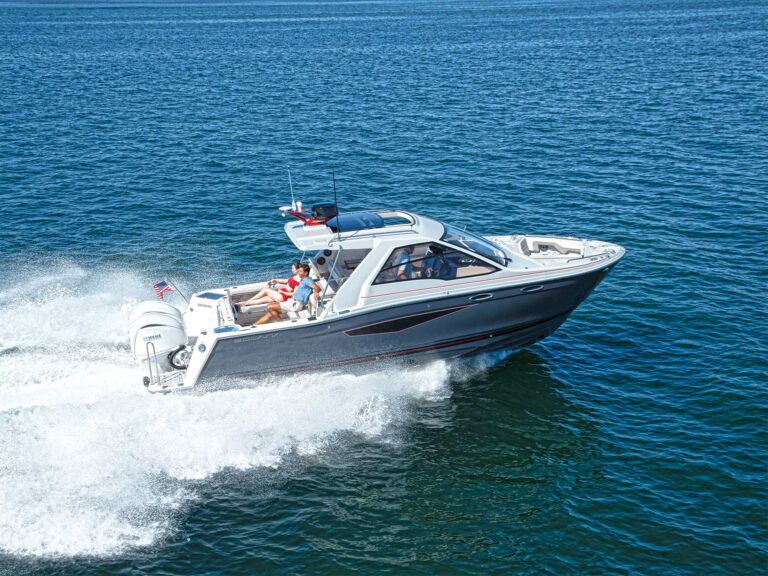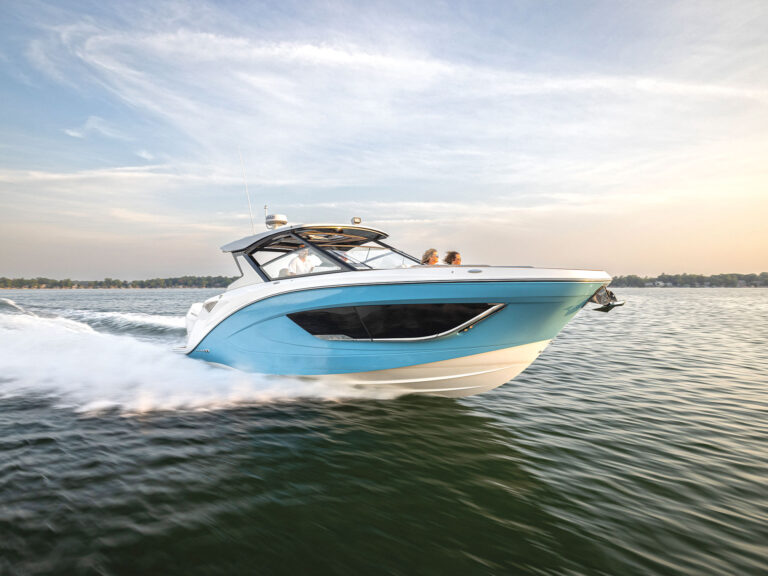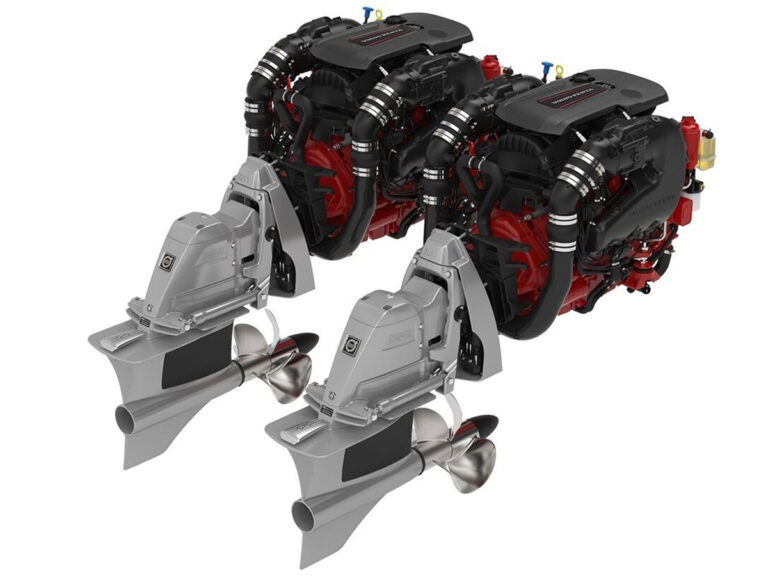It’s easy to oversimplify why a boat displays an exemplary quality. Soft ride? Must be the deep deadrise. Fastest in class? It must be the strake design. Expensive? Must be the vinylester resin. The problem with such blanket statements is that they’re misleading. They make you think all that’s needed to make the right boat choice is an understanding of a few esoteric terms. In truth, a boat is more than the sum of its parts. All those parts should be scrutinized but then contemplated as a whole.
Take the extraordinarily quiet ride of Meridian’s 408 Motoryacht. Chalking up the silence to the underwater exhaust system is easy: A submerged exhaust outlet definitely quiets the roar of twin diesels. But if you based your entire argument on that alone, you’d miss that the motor mounts are through-bolted to cored stringers, which makes for sturdy construction but also deadens vibration and sound. You’d also miss noting that the engine spaces are insulated like a Quonset hut in Antarctica-this contains sound but also helps keep the cabin cool, even after the engines have been running for hours. Then you’d overlook the deckhouse and flying bridge construction, which features an internal “whalebone” grid of U-shaped beams for support to add strength and rigidity and quell creaks and groans.
Don’t stop there: Check the huge frameless salon windows. They provide quite a view, but they also don’t rattle like framed windows. By bypassing the systems approach, you’d miss that Meridian took all noise sources into consideration when building the boat-that it executed a plan to quiet the boat as a whole. And you’d miss the opportunity to see how, like dominoes, even seemingly disparate boat features are interrelated and interdependent-and how aboard the 408 Motoryacht, these relationships are balanced better than most.
POWER TO THE PEOPLE. So now let’s take a systems approach to assess the 408 Motor-yacht’s ride. Vertical accelerations, roll period, and the ability to rise easily to oncoming waves are some of its primary components. During my test, the 408 Motoryacht scored high: It never slammed, it displayed an easy, snap-free roll when beam-to the seas, and it lifted easily over oncoming waves and wakes.
Performance also has many components. Powered by a pair of 330-bhp Cummins MerCruiser 330B diesels, the 408 Motor-yacht performs similarly to other boats in this class, including Silverton’s 39 Motoryacht ($345,275 with twin 350-bhp Caterpillar 3126 diesels) and Carver’s 396 Motoryacht ($398,514, powered like our test boat). Topping out at 26.6 mph, the Meridian settled into a comfortable cruise speed of 23 mph at 2600 rpm. Close quarters maneuvering is outstanding. I pivoted and backed the 408 Motoryacht gracefully into a tight slip, despite a stiff crosswind. In my opinion, this is reason alone for buying diesel power instead of the gas engines many boaters opt for in this type of boat. Diesels are torquier and can swing bigger props, which equals easier pivoting. Equip the 408 Motoryacht with Docking on Command ($14,980), a bow and stern thruster system operated by a single, puck-shaped joystick, and all docking concerns are alleviated.
I was less pleased with the 408 Motoryacht’s ability to plane. Its bow rose to six degrees, then hung for a beat before coming down. If the extra cost, slightly increased fuel burn, and moderately reduced range (there’s that interdependence again) don’t bother you, consider spending an additional $10,810 for the 370-bhp Cummins MerCruiser 370Bs. You may not have to lean as hard on the trim tab switches as I did to get over the hump if you do.
THE VIEW FROM ABOVE. It’s not often that the view from the salon of a midsize boat is one that’s up as well as out. But thanks to two tiers of cabin-length windows, that’s exactly what the 408 Motoryacht delivers. I know you’ve heard it before, but this produces a truly wide-open feel in the cabin. In fact, 1970s-era sedans, which had windows framed on three sides, are the only boats I can recall offering this much natural light. Of course, the windows on those boats leaked, and they rattled and buzzed like a snake trying to mate with a bumblebee.
The 408 Motoryacht’s windows are frameless, set against molded stops and glued in place with adhesive. Floating, as it were, on the glue, they don’t rattle. And leaks are eliminated. I’d prefer the glue to be a lighter color-on test day the temperature was in the 90s, and when I touched the bead of black adhesive, it was softer than Silly Putty. It wasn’t running, but had I been scrubbing the boat, things might have gotten messy. Meridian says it has since changed the adhesive, but check it out for yourself when you do your walkthrough.
RIGHTEOUS. The 408 Motoryacht’s accommodations are an ergonomic tour de force. Forward is a huge guest stateroom; note the innerspring mattress. More subtly, note that you don’t have to turn sideways to get through its door, which is wider than most. Now sit on the commode in the day head. There’s more than 2′ of space between it and the shower stall.
In the galley, you’ll note that there’s a toekick under all cabinetry, an uncommon feature. Now pull open the hatch in the galley sole. More than just a bulk bin, you’ll see drawers that slide out from its sides, doubling its stowage capacity and making organization easier. It’s one of the best uses of “dead” space I’ve seen.
Aft is the master stateroom, which features a split head and shower arrangement. Two separate rooms means two people can use the facility at the same time. The berth is a queen-size platform with an innerspring mattress. You can hop in from three sides, and it’s thigh high-just like home. The woodwork here and throughout the boat is gorgeous, and I applaud Meridian’s use of real wood instead of plastic laminate, which scratches easily. A no-no, though, was discovered beneath a sole hatch. Although the stern thruster batteries and starboard rudder post are easily accessible here, I can’t see how you’ll ever service the port rudder stuffing box without hauling the boat.
The master stateroom’s headroom is more than 6′ and that includes the head compartments. But if you go topside and descend the steps to the swim platform, you’ll see how it was achieved. The step risers are 11″ tall, which makes the steps steep but provides all that headroom.
As I said, seemingly disparate features are all connected aboard a boat.
The Highs: Tremendous amount of natural light in the cabin. Docks so well you’ll feel like Capt. Nemo. Real wood cabinets and paneling mean fewer scratches, easier repair, and a warmer feel.
The Lows: Acceleration is a bit sluggish: Buying more horsepower will kick things up. Aft deck steps are mountain-goat steep. The refrigerator door opens aft and needs a latch to keep it from opening inadvertently.
EXTRA POINT: Southern boaters may balk at all the fabric-fading tropical sun allowed in by the Meridian’s expansive glass windows. Take heart: A canvas sunshade for the windshield is standard.
LOA………………42’2″ ** **
Beam…………….14’4″ ** **
Draft (max.)……3’10” ** **
Displacement (lbs., approx.)……….29,000
Transom deadrise……………10° ****
Bridge clearance………..14’4″ ****
Minimum cockpit depth………………1’10”
Max. cabin headroom………..6’10” ****
Fuel capacity (gal.)……330 ****
Water capacity (gal.)……..90 ****
Price(w/standard power)………$336,885 ****
Price (w/test power)………$379,460
Standard power Twin 370-hp MerCruiser 8.1 Horizon gasoline inboards.
Optional power Twin gasoline inboards to 840 hp total; twin diesel inboards to 740 bhp total.
Test boat power Twin 330-bhp Cummins MerCruiser 330B diesel inboards with 359 cid, 4.02″ bore x 4.72″ stroke, swinging 24″ x 24″ four-bladed Nibral props through 1.96:1 reductions.
Standard equipment (major items): Hardtop; aft deck wetbar; depthsounder; trim tabs; AM/FM/ CD stereo w/4 speakers; 24″ flat-screen TV; 3-burner cooktop; microwave/convection oven; refrigerator/freezer; 2 heads w/shower stalls and vacuum-flush commodes; dual 30a shorepower; 30a battery charger; 12-gal. water heater; internal sea strainers; freshwater cooling.

